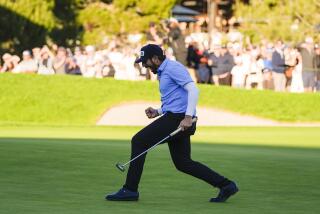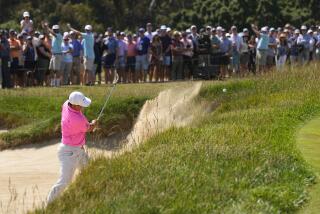Nissan At Riviera L.A. Open : After His ’95 Run, He Needs the Rest
- Share via
Corey Pavin was a breath of fresh air when he first burst on the pro golf tour in 1982. He didn’t play that kind of grim-lipped, lemme-outta-here! game so favored by his tournament contemporaries, who tended to approach the game as if they were on their way to the electric chair.
First, there was that kind of jaunty walk. It was right out of a Chaplin movie. Everything but a dandelion in the buttonhole as he scampered down the fairway as if the Keystone Kops were giving chase. His practice swing looked like a guy beating a carpet. He managed to look nervous even though he wasn’t.
Golfers never hurry but Pavin did. He ran after shots. Who can forget his running after the four-wood shot that won him the U.S. Open last year at Shinnecock Hills? He swung, then took off like a guy chasing a bus. He almost beat his ball to the green and was right there when it slid to a stop five feet from the hole.
That was vintage Pavin. The whole story right there. He played the game like a kid playing mumbletypeg, not a corporate executive closing a merger. Other golfers agonized over shots till they became cobwebbed. Corey merely scurried after his ball and hit it again when it stopped moving.
He took failure in stride. Success too. He knew golf for the treacherous foe it always was, lurking in ambush for the unwary. He knew it wasn’t fair. He knew good shots often went unrewarded while bad ones sometimes took lucky bounces. Pavin just shrugged. And grinned.
He always had this little half-smile, anyway, as if he knew a joke nobody else did. He was emotional but not temperamental. When he won his first Bob Hope tournament in 1987 on the despotic Stadium course at PGA West, he leaped about six feet straight up, his legs tucked underneath him like a duck’s. When he crouched on a green, sizing up a putt, he was able to squat down to where the ball was eye-level, and got up without touching the ground. It hurt to watch. He seemed triple-jointed.
He was short--5 feet 9 if you believed the tour guide, a little less if you believed your eyes--but many, if not most, of your great players were short. Corey was short, but his game wasn’t.
The tour found out quickly that Pavin was special. He didn’t play to win money, he played to win tournaments. The registered giants of the game found him in their rear-view mirrors. He has won 13 times on tour but he has been second 16 times, and he’s 5-3 in playoffs.
But, that was then. He’s the reigning U.S. Open champion but people are talking of his “comeback” at the Nissan Open at Riviera this week.
Now, comeback is a word usually associated with a washed-up prizefighter who comes out of retirement for one more whack at the title, or a paycheck. Strictly speaking, Corey Pavin has not been anywhere. And that’s just the trouble. He hasn’t fired a golf shot in earnest or in anger for six weeks. There hasn’t been a putt he had to make for a month. He hasn’t even had a golf club in his hand all that time.
This usually adds up to a fatal deficiency in adrenaline, among other things. There are some sports you can turn it on and off like a garden hose, but golf isn’t one of them.
One of the perks of winning the U.S. Open is, you get to play in those quick-and-easy-money postseason television gimmicks--the Grand Slam, the Skins Games, the million-dollar challenges. Carnival golf.
The proposition is, golf is a game that can only be perfected under pressure. A few golfers, blessed with repeating swings they can call out at will, get away with infrequent play. Ben Hogan could tee it up in six tournaments in 1953, win five of them--the Masters, U.S. and British Opens among them--and finish in a tie for third in the sixth. Jack Nicklaus could play in only 19 tournaments in 1972 and win seven of them--among them the Masters and U.S. Open--and finish second in the British.
But the rank-and-file golfer needs to keep that competitive edge honed. A golf game cannot be picked up and put down like a knitted quilt.
Which is why the golf establishment will be peering closely as Corey Pavin takes his game out of mothballs at Riviera today and rejoins the dock fight.
Pavin doesn’t see a problem. But, then, he never does. Corey wouldn’t see a problem on the Titanic. He figures life is just another long par-five over water. Nothing that can’t be handled by faith and a four-wood to an elevated green you run after.
“Nah!” he says. “I often used to take a few weeks off. You need to. No big deal. It all comes back to you soon enough when you get back out there where they’re shooting at you.”
The golf world will be waiting to see. After all, Pavin has won this tournament the last two years. Hogan’s Alley is becoming Pavin’s Patch.
Pavin never was a dilettante player. He has teed it up in as many as 29 events a year more than once. But the locker room wisdom says you need to get out in a crowd of guys capable of throwing a 63 at you. Otherwise, the game--like the player--gets complacent.
Corey scoffs. He never hit a shot that wasn’t packed with tension anywhere, he insists. He treats every shot as if it were on the back nine at Augusta on Sunday.
“I never hit a shot where I say, ‘That doesn’t matter,’ ” he says. “Every shot matters to me.”
Does the game need Corey Pavin back on the stick? The game needs all the Corey Pavins it can get.
Still, the notion persists that Pavin’s swing will need some oil for rusted parts if he is to win this week. Otherwise, when he chases down his four-wood to the 18th green this time, he may not like what he sees when he gets there.
More to Read
Go beyond the scoreboard
Get the latest on L.A.'s teams in the daily Sports Report newsletter.
You may occasionally receive promotional content from the Los Angeles Times.










